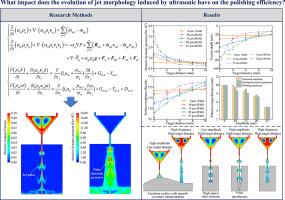超声波诱导的射流形态对抛光效率的影响
IF 7.1
1区 工程技术
Q1 ENGINEERING, MECHANICAL
International Journal of Mechanical Sciences
Pub Date : 2024-10-01
DOI:10.1016/j.ijmecsci.2024.109764
引用次数: 0
摘要
在磨料射流抛光(AJP)过程中,对射流束施加超声波振动可有效提高磨料颗粒的切割动能,但同时也会导致射流形态发生显著变化。然而,关于射流形态与抛光效率之间关系的研究较少。本文建立了一个流体力学模型来研究射流形态演变对抛光效率的影响。通过高速摄像捕捉、定向侵蚀实验和抛光实验,从多个角度验证了计算结果的准确性。研究发现,每个振幅都存在一个有效目标距离,超过这个距离,超声波振动就无法提高抛光效率。可以通过降低振幅或提高频率来扩大有效目标距离。研究结果揭示了超声波振动诱导的脉冲形态演变过程以及脉冲动压随目标距离的变化规律,为设计超声波振动增强 AJP 工艺中的振动参数提供了理论依据。本文章由计算机程序翻译,如有差异,请以英文原文为准。

The impact of ultrasonic-induced jet morphology on polishing efficiency
In the abrasive jet polishing (AJP) process, applying ultrasonic vibration to the jet beam can effectively improve the cutting kinetic energy of the abrasive particles, but it simultaneously causes significant variations in the jet morphology. However, less research has been done on the relationship between the jet morphology and the polishing efficiency. This paper established a fluid mechanic model to study the effect of jet morphology evolution on the polishing efficiency. The accuracy of the computational results was verified from multiple perspectives through the high-speed camera capture, the targeted erosion experiments and the polishing experiments. It was found that there exists an effective target distance for each amplitude, beyond which ultrasonic vibration cannot improve the polishing efficiency. The effective target distance can be expanded by reducing the amplitude or increasing the frequency. The research findings reveal the evolution process of the pulse morphology induced by the ultrasonic vibration and the variation pattern of pulse dynamic pressure with respect to the target distance, which can provide a theoretical basis for designing the vibration parameters in the AJP process enhanced by the ultrasonic vibration.
求助全文
通过发布文献求助,成功后即可免费获取论文全文。
去求助
来源期刊

International Journal of Mechanical Sciences
工程技术-工程:机械
CiteScore
12.80
自引率
17.80%
发文量
769
审稿时长
19 days
期刊介绍:
The International Journal of Mechanical Sciences (IJMS) serves as a global platform for the publication and dissemination of original research that contributes to a deeper scientific understanding of the fundamental disciplines within mechanical, civil, and material engineering.
The primary focus of IJMS is to showcase innovative and ground-breaking work that utilizes analytical and computational modeling techniques, such as Finite Element Method (FEM), Boundary Element Method (BEM), and mesh-free methods, among others. These modeling methods are applied to diverse fields including rigid-body mechanics (e.g., dynamics, vibration, stability), structural mechanics, metal forming, advanced materials (e.g., metals, composites, cellular, smart) behavior and applications, impact mechanics, strain localization, and other nonlinear effects (e.g., large deflections, plasticity, fracture).
Additionally, IJMS covers the realms of fluid mechanics (both external and internal flows), tribology, thermodynamics, and materials processing. These subjects collectively form the core of the journal's content.
In summary, IJMS provides a prestigious platform for researchers to present their original contributions, shedding light on analytical and computational modeling methods in various areas of mechanical engineering, as well as exploring the behavior and application of advanced materials, fluid mechanics, thermodynamics, and materials processing.
 求助内容:
求助内容: 应助结果提醒方式:
应助结果提醒方式:


